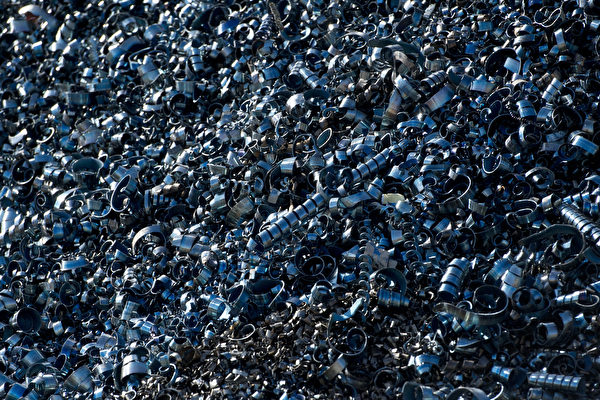With the increasing demand for AI, electric vehicles, chips, and other technologies, energy consumption is on the rise, making energy optimization and pollution reduction key priorities. A university in the UK conducted a study to convert industrial metal waste into catalyst enhancers in order to reduce the cost of hydrogen production and promote waste reuse.
Hydrogen gas is commonly used in petrochemical plants and can also be used to produce agricultural chemicals like urea and ammonia, as well as fuels for vehicles. Hydrogen combustion generates harmless water vapor when reacting with oxygen in the air.
However, hydrogen production heavily relies on electricity, water, and catalysts. Catalysts commonly used in hydrogen production are expensive precious metals like platinum (Pt) and cobalt (Co). The escalating prices of precious metals due to geopolitical conflicts and inflation pose challenges to the hydrogen production industry, necessitating strategies to reduce precious metal use or increase hydrogen output.
Researchers at the University of Nottingham in the UK discovered that metal shavings generated from industrial cutting processes could serve as effective catalyst supports, reducing the need for precious metals and lowering hydrogen production costs. Their research was published on April 16 in the Journal of Materials Chemistry of the Royal Society of Chemistry.
Mechanical processes such as turning, milling, and drilling create significant amounts of low-value metal waste from cutting aluminum-magnesium alloys, stainless steel, titanium (Ti), nickel (Ni), and other alloys. However, a large portion of this waste is not efficiently recycled but rather disposed of due to limited economic incentives for recycling.
Although some metal waste is currently used as substitutes in laser additive manufacturing or solid-state sintering processes, a substantial amount of metal waste still remains unutilized. Prior to this study, there was no consideration of using such waste in the field of catalysis.
The University of Nottingham primarily utilized metal shavings from turning processes in their experiments. The metal surface’s formation of numerous 10-50 nanometer (nm) grooves and protrusions after machining provides a high surface area, facilitating adsorption and stabilizing catalytic solutions.
Researchers immersed titanium and nickel metal shavings in solutions containing platinum and cobalt, creating Pt-Ti and Co-Ni configurations on the nanoscale protrusions and grooves without the need for additional solvents or reagents, allowing platinum or cobalt to adsorb onto the titanium and nickel metals.
Experiments showed that per square centimeter of titanium metal shavings, only 28 micrograms of platinum were needed to produce combustible hydrogen, which is one-tenth of the commercial catalyst usage. Similarly, 30 micrograms of cobalt on each square centimeter of nickel metal shavings was sufficient for producing oxygen assist gas (O2). Both demonstrated an impressive 100% Faraday efficiency, offering significant commercial value.
In addition, researchers assessed the hydrogen evolution reaction (HER) and oxygen evolution reaction (OER) capabilities of titanium, stainless steel, and nickel metal shavings with and without the addition of platinum and cobalt materials.
Results indicated that the metals with platinum and cobalt additions exhibited higher responses in both OER and HER compared to the non-additive reactions, with significantly increased yields. Notably, titanium and nickel shavings initially without platinum showed a 60-fold and 4-fold increase in activity, respectively, after platinum addition.
Furthermore, long-term durability tests conducted on these platinum-added metals showed significant stability in titanium and nickel electrodes with nearly no decrease in current, while stainless steel demonstrated a 15% decrease.
These experiments confirm that with proper platinum or cobalt additions, the device can enhance the capacity and efficiency of oxygen and hydrogen production. Implementing this process could help address waste metal generated by modern industries and the high cost of hydrogen production.
Dr. Jesum Alves Fernandes, head of the research team at the University of Nottingham’s School of Chemistry, stated: “The UK’s industries produce millions of tons of metal waste annually. When we examined them using scanning electron microscopy, we were surprised to find that stainless steel, titanium, or nickel alloy shavings, despite their smooth appearance, contain numerous tens of nanometers wide grooves and protrusions.”
Dr. Madasamy Thangamuthu, responsible for analyzing the structure and electrocatalytic activity of new materials, mentioned: “Compared to state-of-the-art commercial catalysts, we only spent one-tenth of the water and a minimal amount of precious and waste metals to create a laboratory-scale electrolytic cell for hydrogen production, achieving an overall operational efficiency of 100%.”
Currently, the team is collaborating with AqSorption Ltd to scale up their technology. Professor Andrei Khlobystov from the university added: “By using metal waste from the aerospace industry and minimal precious metal inputs, we have developed a process for hydrogen production that upgrades and reuses metal waste from the aerospace industry.”

